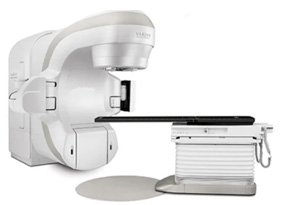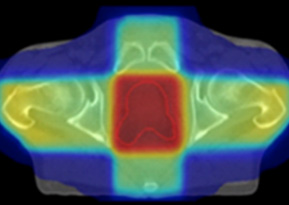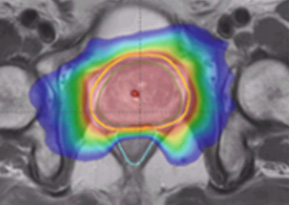New Patients
What is Radiation Therapy?
There are many different types of radiation therapy. Think of radiation therapy like energy that we use to get rid of cancer cells. Some radiation is made with a special machine and comes from outside the body (“external” radiation, also called “external beam radiation”), similar to the kind of energy used in a CT scan. This is a noninvasive treatment. Other radiation comes from devices we put inside the body (“internal” radiation, also called “brachytherapy”).
The way we use radiation therapy to treat cancer is customized to the kind of cancer needing treatment. The word “cancer” refers to hundreds of different diseases. Nearly every part of the body can have tissue growing abnormally, and it is up to us to understand how this tissue behaves, if it is a danger to you, and how we can get rid of it, if needed. We start by understanding the extent of the situation – how severe is the disease? How much treatment do we need? Do we need to treat it at all? What is the best treatment to help your case? These topics and more will be discussed with you during your appointments.

External Beam RT (non-invasive)

Example of older-style treatment

Example of newer-style treatment
Radiation Oncology Videos
Below are a series of short videos made by the Tennessee Oncology radiation oncology team for our patients and families. They address radiation therapy and side effects for different types of cancer.
Example Office Visit Calendar
The below example calendar is from a patient recommended for 6 weeks of radiation therapy.
| Sunday | Monday | Tuesday | Wednesday | Thursday | Friday | Saturday |
|---|---|---|---|---|---|---|
| 30 | 31 | 1 | 2 | 3 | 4 | 5 |
| 6 | 7 | 8 | 9 | 10 | 11 | 12 |
| 13 | 14 | 15 | 16 | 17 | 18 | 19 |
| 20 | 21 | 22 | 23 | 24 | 25 | 26 |
| 27 | 28 | 29 | 30 | 31 | 1 | 2 |
| 3 | 4 | 5 | 6 | 7 | 8 | 9 |
| 10 | 11 | 12 | 13 | 14 | 15 | 16 |
| 17 | 18 | 19 | 20 | 21 | 22 | 23 |
| 24 | 25 | 26 | 27 | 28 | 29 | 30 |
| 1 | 2 | 3 | 4 | 5 | 6 | 7 |
| 8 | 9 | 10 | 11 | 12 | 13 | 14 |
1. Consultation
2. CT Simulation
3. Treatment
- Includes once-weekly visit with Physician
- As needed visits for help with side effects.
4. Follow-up
- Depends on the cancer type
| Event | Duration | Notes |
|---|---|---|
| Referral | ||
| Consultation | 1-1.5 hours | To discuss your case, the recommended treatment, possible side effects, etc. |
| Simulation | 1-1.5 hours | Also called a “radiation planning CT,” this appointment is to determine the position for your body during treatment; often includes a CT scan. |
| Treatment Planning | 3-7 business days | While you’re waiting for treatment to start, your team of doctors and other key staff make design the machine instructions in software and verify its readiness for treatment. |
| Treatment | Typically 3-7 weeks, once daily, Monday-Friday | Individual treatments are typically quick (30-40 minutes in-office each day). At least once per week, you briefly meet your doctor for a check-up = “on-treatment visit” – the day of this visit varies by provider. |
| Follow-up | Your doctor sees you back after treatment to help with any side effects, and to monitor for any sign of recurrence. |
Radiation Therapy FAQs
How do you decide what kind of technology to use to treat my cancer?
There are many different types of radiation therapy, and each treatment decision is based on data (Does it work? How well does it work? Do any of the other kinds work better for cancer outcome or reduce side effects? Etc). The stage of the cancer and your symptoms at the start of treatment also affect what we choose. Your team will explain during your visit.
Will I be radioactive?
For External Beam radiation, you will not be radioactive at any time. The treatment machine delivers energy into the body, and once the machine is off, there is no radiation in the room. The effect (cancer treatment) as well as side effects/symptoms build up over time during the treatment course, similar to the effect of sun on skin building up over time after an hour of daily exposure.
Are there any activities I should avoid?
In general, there are no restrictions on your activity during this treatment. Exercise if possible. Stay active, and eat well. If there are other specific recommendations for your case, your team will explain during your visit.
Do I need to take any supplements?
In general, no, you do not need any specific supplements. If there are other specific recommendations for your case, your team will explain during your visit.
What is CyberKnife? Any advantage for my case?
As the profession and the technology have evolved, certain machines have advantages and disadvantages. Before our current models became very precise, a developer built an x-ray producer onto the same robot used to build cars, and it was called “CyberKnife.” The robot can move to many angles, and that can be helpful, though it can also be slow compared to other machines. If CyberKnife is recommended for your case, your team will explain during your visit.
What is “SBRT”? Any advantage for my case?
You may or may not be eligible for a much quicker form of radiation therapy called “SBRT.” As technology has improved, and treatments are more precise, shorter treatment courses became possible for many cancers. An advanced kind called “stereotactic body radiation therapy” (SBRT, or SAbR) was pioneered in the 1990s and 2000s, and it is completed in 5 treatments or less. If SBRT is recommended for your case, your team will explain during your visit.
What is protons? Any advantage for my case?
Certain cancer cases benefit from a specific form of external beam radiation called “proton therapy.” Proton therapy hopes to minimize the amount of radiation given to non-cancer tissue (“normal tissue”) in the body by focusing the treatment on the cancer in a different way than most External Beam radiation. If proton therapy is recommended for your case, your team will explain during your visit.








